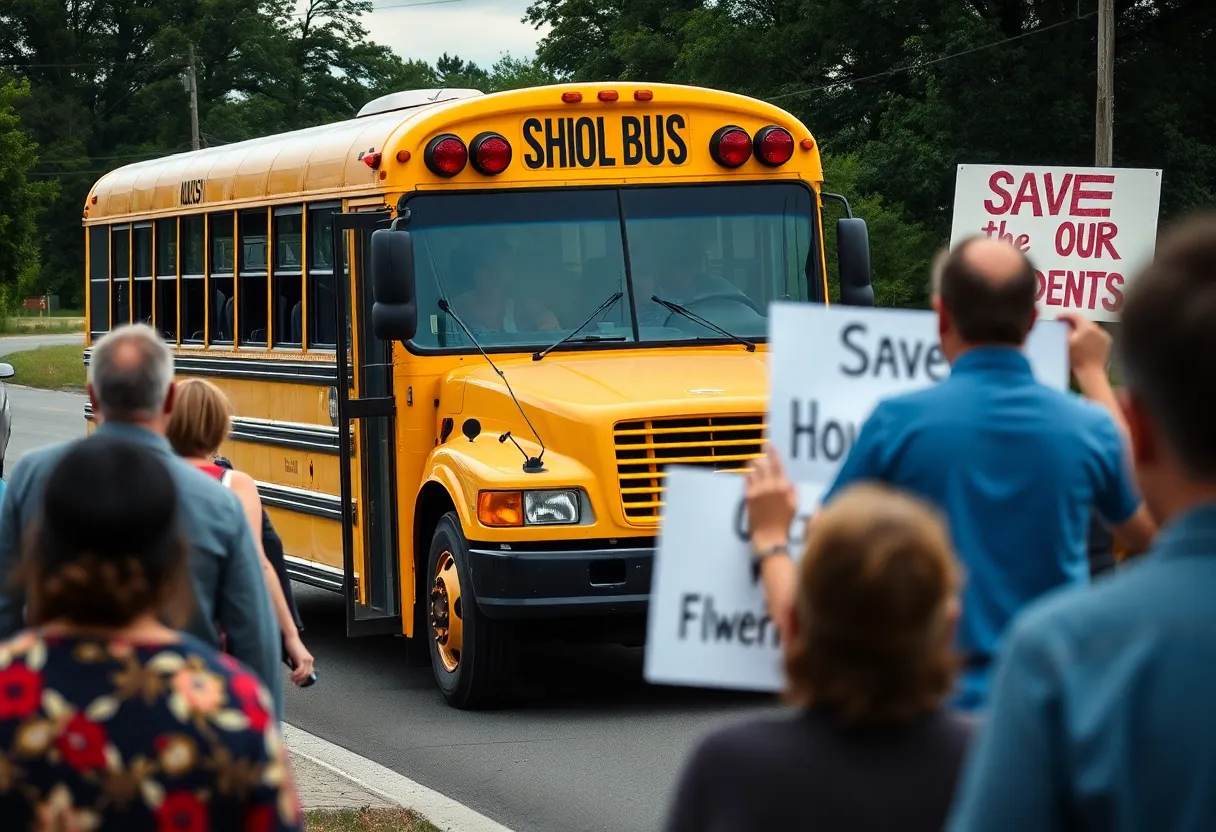Tucson, October 27, 2025
The Tucson Unified School District (TUSD) has announced a controversial transportation policy redirecting students from Rita Ranch to Cienega High School. Effective next semester, this policy raises concerns about longer commute times and safety for approximately 450 affected students. Critics argue it may compromise both safety and overcrowding at Cienega High, which is currently operating at 95% capacity. The decision, aimed at cutting costs by $1.2 million annually, has mobilized local advocates to protest and seek a public referendum amidst ongoing budget challenges.
Tucson School District Announces Controversial Transportation Policy Shift
Tucson, AZ – The Tucson Unified School District (TUSD) has introduced a new transportation policy effective next semester, redirecting students from the Rita Ranch area to Cienega High School to cut costs and optimize routes. This decision, announced on October 27, 2025, has sparked widespread backlash from parents concerned about longer travel times and safety risks.
Key Changes and Immediate Concerns
The policy restricts busing to specific designated routes, funneling Rita Ranch students exclusively to Cienega High School. This affects around 450 students who previously had more flexible options. Parents at a recent school board meeting voiced strong objections, highlighting potential increases in commute durations and hazards on rural roads not equipped for heavy student traffic. TUSD officials argue the shift will generate annual savings of $1.2 million, allowing reallocation of funds to essential programs without compromising educational standards.
While the district emphasizes efficiency, community members point to Cienega High School’s current 95% capacity as a looming issue. Redirecting more students could intensify overcrowding, straining facilities and resources. Families in Rita Ranch, many of whom rely on school transportation due to work schedules, fear disruptions to daily routines. TUSD has pledged free shuttle services as a stopgap, but doubts persist among stakeholders about their reliability and coverage.
Broader Context and Community Response
This policy emerges amid TUSD’s ongoing budget challenges driven by declining enrollment across the district. Officials describe the changes as a necessary step to balance finances while prioritizing student needs. The redirection aims to streamline operations by concentrating resources on high-demand areas, but critics contend it undermines equity for suburban families who depend on consistent busing.
Local advocates are mobilizing, with plans for protests scheduled next week. They seek a public referendum to potentially overturn the decision, arguing that community input was insufficient during the planning phase. The meeting saw a packed crowd, underscoring the depth of local engagement and frustration. Discussions also touched on how the policy might disproportionately impact working parents, who could face logistical hurdles in adjusting drop-off and pick-up times.
Impacts on Students and Families
For the 450 affected students, the switch means adapting to new travel patterns starting next semester. Safety remains a top worry, particularly on less-traveled rural paths where emergency services might be slower to respond. TUSD assures that all routes will meet state safety guidelines, with added monitoring for high-risk areas. However, the transition period could bring temporary chaos, as families scramble to reorganize carpools or alternative arrangements.
Supporters of the policy highlight long-term benefits, such as reduced operational waste and more funds for classroom enhancements. Yet, the immediate fallout has dominated conversations, with calls for transparent data on projected overcrowding and cost breakdowns. The district has committed to regular updates and feedback sessions, but trust appears eroded among those feeling sidelined.
Historical Background on TUSD Transportation Policies
TUSD has faced similar debates in recent years as enrollment trends and funding pressures reshape district strategies. Previous adjustments to busing have aimed at cost containment, but none have provoked the level of outcry seen now. This latest move reflects a district-wide push toward efficiency, part of broader efforts to navigate Arizona’s evolving education landscape. Enrollments have dipped due to factors like population shifts and competition from charter schools, forcing tough choices on resource distribution.
The Rita Ranch to Cienega redirection underscores tensions between urban and rural needs within TUSD’s expansive service area. While urban schools grapple with different pressures, suburban zones like Rita Ranch often bear the brunt of consolidation efforts. Community leaders warn that without equitable solutions, such policies could widen divides, prompting more families to explore private or alternative education options.
Looking Ahead
As protests loom, TUSD faces a pivotal moment in rebuilding community ties. The district’s promise of shuttle alternatives and resource funneling seeks to address core concerns, but execution will be key. Ongoing debates in Tucson education circles continue to pivot on themes of equity, safety, and fiscal responsibility, with this policy serving as a flashpoint. Families and officials alike await further details on implementation, hoping for a balance that serves all students without undue burden.
This development highlights the complexities of public education management, where savings must align with student well-being. TUSD’s actions in the coming weeks will likely shape future trust and participation in district decisions. With 450 students at stake, the focus remains on minimizing disruptions while pursuing sustainable efficiencies.
FAQ
Frequently Asked Questions
What is the new transportation policy announced by TUSD?
The Tucson Unified School District (TUSD) has introduced a new transportation policy effective next semester, redirecting students from the Rita Ranch area to Cienega High School to cut costs and optimize routes.
How many students are affected by this policy?
This policy affects approximately 450 students.
What are the main concerns raised by parents?
Parents have expressed concerns about longer commutes and safety risks on rural roads.
How much money will TUSD save with this change?
TUSD officials state the policy will generate annual savings of $1.2 million.
What is the capacity situation at Cienega High School?
Cienega High School is currently at 95% capacity, and redirecting more students could intensify overcrowding.
Are there any alternatives being offered?
TUSD has pledged free shuttle services as a stopgap measure.
Why was this policy introduced?
The policy emerges amid TUSD’s ongoing budget challenges driven by declining enrollment across the district.
What actions are community members planning?
Local advocates are mobilizing, with plans for protests scheduled next week, seeking a public referendum.
Key Features of TUSD’s New Transportation Policy
| Feature | Description |
|---|---|
| Affected Area | Rita Ranch students redirected to Cienega High School |
| Number of Students Impacted | Approximately 450 |
| Effective Date | Next semester |
| Annual Savings | $1.2 million |
| Target Capacity at Cienega | Currently at 95% |
| Alternatives Provided | Free shuttle services |
| Main Concerns | Longer commutes and safety on rural roads |
| Community Response | Planned protests and push for referendum |
Deeper Dive: News & Info About This Topic
HERE Resources
Tucson Youth Soccer League Expands with City Grant
Interstate 10 Reopens After Fatal Crash Near Tucson
Tucson Unified School District Proposes Transportation Overhaul Amid Budget Crisis
Pima County Approves $30 Million Infrastructure Project for Tucson International Airport
Tucson Medical Center Announces $20 Million Oncology Wing Expansion
Tucson Sees 12% Surge in Commercial Leases Driven by E-commerce Boom
Tucson to Host Major Defense Industry Expo
Tragic Death of Beloved Teacher Shakes Sunnyside High School Community
Road Reopens After Fatal Crash at Tucson Intersection
South Tucson Breaks Ground on New Affordable Housing Project




